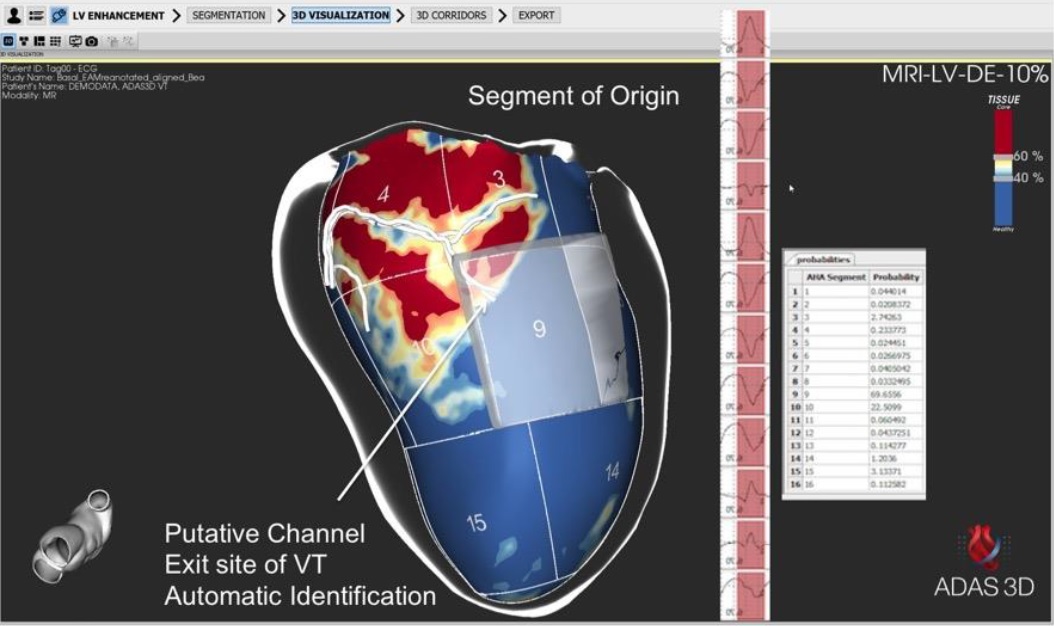A new tool manages to identify the precise anatomical location of ventricular arrhythmias
Researchers from the BCN Medtech Research Unit have participated in its development, which will facilitate interventional treatment of ventricular tachycardias through safer, more efficient procedures.

A multidisciplinary team of researchers and physicians has developed a new commercial tool that is able to identify the exact location of ventricular arrhythmias prior to an ablation procedure. Thanks to this, it is possible to plan the procedure far more efficiently and safely. The development of this new tool has enjoyed the support of the European Commission through the ATTRACT plan.
The tool is the result of the project MERIT-VA (AutoMatic integration of electrocardiogram and cardiac Magnetic Resonance Imaging to guide caTheter-based substrate ablation for Ventricular Arrhythmias), coordinated by the team of Dr. Antonio Berruezo, director of the Department of Arrhythmias and of Research and Innovation at the Institut del Cor Quirónsalud Teknon, with the collaboration of researchers from the UPF BCN Medtech Research Unit and the medical image post-processing software company ADAS 3D Mèdical SL.
Òscar Càmara: “The novel use of computer tools in electrocardiographic signals allows automating their analysis and reducing clinical intervention times.”
“This new tool will facilitate the interventional treatment of ventricular tachycardias, which cause sudden death, and will allow safer, more efficient procedures”, Dr. Berruezo explains. In addition, he adds that this is the first clinical study that shows the feasibility of training and integrating a model of machine-learning –an emerging discipline that defines computational and statistical methods that enable computers to learn to perform tasks based on existing data– of surface electrocardiogram data in commercially available software that enables correlating the electrocardiogram and heart anatomy, including the presence of myocardial scars, by resonance. Meanwhile, Òscar Càmara, a UPF researcher, assures that “the novel use of computer tools in electrocardiographic signals allows automating their analysis and reducing clinical intervention times”.
A solution for sustained ventricular tachycardia
One of the most prevalent human diseases is acute myocardial infarction, which results in a series of scars on the heart of the affected patient. These scars are formed by a series of channels with surviving myocytes in the scar, which end up causing the appearance of sustained ventricular tachycardia. This type of arrhythmia is the leading cause of sudden cardiac death following acute myocardial infarction.
To treat this disease, a procedure is carried out that consists of the ablation of the substrate that produces the arrhythmia, the channels. This is accomplished through effective invasive treatment consisting of the introduction of a catheter into the patient’s heart through a vein or an artery. This catheter is fitted with sensors that allow its location within the heart, and is also able to record local electrical signals that identify the heart substrate by creating an electroanatomical map. Subsequently, via radio frequency administration, this substrate is removed.
Guiding ablation using cardioresonance imaging increases arrhythmia-free survival and also facilitates the intervention, rendering it safer and more efficient.
Various studies conducted so far by researchers at the Institut del Cor Teknon have shown that guiding ablation using cardioresonance imaging increases arrhythmia-free survival and also facilitates intervention, rendering it safer and more efficient. “These studies were what motivated us to launch this MERIT-VA project, which has now allowed us to become yet more efficient and to develop this new tool so that this way of performing ablations can be exported to other centres in the near future”, Dr. Berruezo points out.
